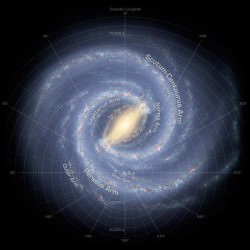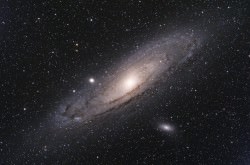You’ve probably heard the saying “everything’s relative”. When you consider our place in the Universe, everything really is relative. I’m recording this halfway up Vancouver Island, in the Pacific Ocean, off the West Coast of Canada. And where I’m standing is about 6,370 kilometers away from the center of the Earth, that way.
From my perspective, the Sun is over there. It’s as large as a dime held at arm’s length. For me it’s really, really far away. In fact, at this exact time it’s further away than any object I you can see with the naked eye.I’m about 150 million kilometers away from the Sun, and so are you.
We’re carving out an elliptical orbit which takes one full year to complete one whole trip around. You, me and the Earth are all located inside our Solar System. Which contains the Sun, 8 planets and a vast collection of ice, rocks and dust. We’re embedded deep within our galaxy, the Milky Way. It’s a big flat disk of stars measuring up to 120,000 light years across.
Our Solar System is located in the middle of this galactic disk. And by the middle, I mean the center of the galaxy is about 27,000 light years that way, and the edge of the galaxy is about the same distance that way.
Our Milky Way is but one galaxy in a larger collection of galaxies known as the Local Group. There are 36 known objects in the local group. Which are mostly dwarf galaxies. However, there’s also the Triangulum Galaxy, the Milky Way, and the Andromeda galaxy… which is by far the largest, most massive object in the Local Group, It’s twice the size and 4 times the mass of the Milky Way.
But where is it?

From me, and you, Andromeda is located just an astronomically distant 2.5 million light years that way. Or would that be just short 2.5 million light-years that away? I’m sure you see where this is going.
The Local Group is embedded within a much larger group known as the Virgo Supercluster, containing at least 100 galaxy groups and clusters. The rough center of the supercluster is in the constellation Virgo. Which as of right now, is that way, about 65 million light years away. Which certainly makes the 2.5 million light years to Andromeda seem like an afternoon jaunt in the family car.
Unsurprisingly, The Virgo Supercluster is a part of a larger structure as well. The Pisces-Cetus Supercluster Complex. This is a vast filament of galactic superclusters measuring about 150 million light years across AND a billion light years long. The middle is just over that way. Right over there.

One billion light years in length? Well that makes Andromeda seem right around the corner. So where are we? Where are you, and I and the Earth located in the entire Universe? The edge of the observable Universe is about 13.8 billion light years that way. But it’s also 13.8 billion light years that way. And that way, and that way.
And cosmologists think that if you travel in any direction long enough, you’ll return to your starting point, just like how you can travel in any one direction on the surface of the Earth and return right back at your starting point. In other words, the Earth is located at the very, very center of the Universe. Which sounds truly amazing.
What a strange coincidence for you and I to be located right here. Dead center. Smack dab right in the middle of the Universe. Certainly makes us sound important doesn’t it? But considering that every other spot in the Universe is also located at the center of the universe.
You heard me right. Every single spot that you can imagine inside the Universe is also the center of the Universe. That definitely complicates things in our plans for Universal relevance. And all this sure does make Andromeda seem close by….and it’s still just right over there, at the center of the Universe. Oh, and about every spot in the universe being the center of the Universe? Well, we’ll save that one for another episode.


You’re skipping over a very interesting distance range, which I think could interest many because it’s kind of geographically tangible and it bridges a fairly unknown size gap between the Solar System’s nearest stars, <100 ly, and the spiral arms of the galaxy, ~10 000 ly. You should do an episode on this stuff!
On the scale of a few hundred light years, we find ourselves in the "local fluff", which is a cloud passing through the "local bubble" which in turn is a part of the "local chimney" structure which fountains matter above the plane of the galaxy. All of this is formed by the rythm of star births in the density waves of the spiral arms. Some mixed 1st found google links:
http://apod.nasa.gov/apod/ap130924.html
https://en.wikipedia.org/wiki/Local_Bubble
http://www.solstation.com/x-objects/chimney.htm
we are located at the center of the observable Universe from our perspective, is what you are getting at right? Clearly not the center of THE Universe. i’m still not sure I buy the “go in any direction long enough and you get back to where you started” but lets check out the relevant Modest Mouse lyric:
“The universe is shaped exactly like the earth if you go straight long enough you’ll end up where you were” : )
i should probably stay out of these types of discussions haha.
I once had a math teacher who made a joke about tigers not being able to count beyond 3. Anything above 3 was alot. So if 10 hunters went into a forest and 6 came out … to the tiger a lot went in, a lot went out … coast is clear.
I have that same thing when you guys use Lightyears. 1 LY, 4 LY or 2,5 MLY …. its all something I cannot comprehend. Its all “a lot”.
What i do comprehend is 1 AU. … If i downsized our MilkyWay to 1AU than Andromeda would be at about 250AU. And the two Magellanic clouds at about 1.6 AU and 2 AU distance. Roughly the distance between the Sun and Mars. Pluto is at ~40 AU and Eris at ~70 AU … so that would make Andromeda at about 6 times the distance to Pluto if our MilkyWay was 1 AU in size.
If I would compare it with our Milkyway being the size of the Sun Mercurius Orbit than Andromeda would still be twice further away then Pluto.
Ah well. So much for “its far” and “its still far”.
And now try to imagine the Andromeda being about 4 times the size of the full moon if it were visible at 250 AU … and that before scaling the Andromeda’s size as well.
“The Virgo Supercluster is a part of a larger structure as well. The Pisces-Cetus Supercluster Complex. This is a vast filament of galactic superclusters measuring about 150 million light years across AND a billion light years long.”
So, we are members of the Fish-Whale Supercluster!
Let me be the first to acknowledge our fish-whale overlords!
Hi all,
Some time back, I gatheres some reasources that were lying around in the internet and created a poster to get an impression where Earth is in the Universe. Have a look, its made for visual impression as well as to tease the mind a little.
http://commons.wikimedia.org/wiki/File:Home_in_Relation_to_Everything.png
Dont miss the full resolution version in the description text.
Cheers,
Semmel
not at least acceptable level accuracy
Thanks for this very nice article providing yet again an amazing recap of what’s “around” us and facts most of us won’t think about when waking up in the morning. It’s an amazing universe.